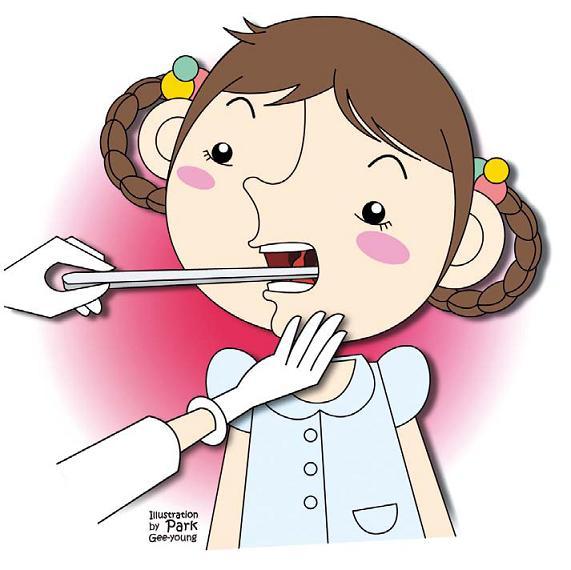Many people think of tonsillitis when they have throat pain. However, there are many structures in the throat, which is why throat pain does not always indicate tonsillitis. Other causes of throat pain include pharyngitis and laryngitis, and these different conditions have different symptoms, for which there are different treatments.
The tonsil tissues help defend against foreign substances from the outside. They play a key immunity role for many years after birth. The palatine tonsils are walnut-shaped tissues on both sides of the uvula ― the piece of soft tissue that hangs at the back of the mouth ― and are commonly referred to as the tonsils. The pharyngeal tonsils are above and behind the uvula and do not easily come together.

Tonsillitis is a condition where there is an inflammation of the walnut-shaped tonsils on both sides of the uvula. The term “tonsillitis” commonly refers to acute tonsillitis, but in general terms it also includes chronic tonsillitis, pediatric tonsillitis and adenoidal hypertrophy.
Tonsillitis is caused by viral or bacterial infection. Factors that induce such infections include common colds and upper respiratory infections, fatigue, malnutrition and changes in climate.
The symptoms of acute tonsillitis include severe pain when swallowing food, body aches, fever and chills. These symptoms differentiate tonsillitis from pharyngolaryngitis. Other symptoms include ear pain, which occurs because the sensory nerves supplying the tonsils and the ears branch from a common nerve.
Chronic tonsillitis is when there is repeated acute tonsillitis. In chronic tonsillitis, there are less acute symptoms. Chronic symptoms include a feeling of a foreign object in the throat and production of smelly phlegm. It causes bad breath and in cases of chronic bad breath without a known cause, chronic tonsillitis may be the culprit.
In chronic tonsillitis, the bacteria in the tonsils can spread to other parts of the body, including the heart, joints and kidneys, causing complications such as rheumatoid arthritis and swollen kidneys. This is particularly dangerous in children.
Pediatric tonsillitis and adenoidal hypertrophy cause a blocked nose, loud snoring, sleep apnea and developmental delays. Another complication is weeping ear infections.
The treatment for this condition includes rest and fluids, along with medication (antipyretics, analgesics and antibiotics). This condition is very treatable. In chronic cases, surgery is often recommended for those who have had five or more episodes of tonsillitis during the year. Tonsillectomy is the usual surgical treatment, and can be done conveniently with a laser. It is also an effective treatment for chronic tonsillitis that causes bad breath.
In children with repeated tonsillitis, significant hypertrophy of the palatine tonsils and adenoids can occur. If this extends over a long time, it can lead to children avoiding solid foods and preferring liquids. This is because they experience breathing problems when swallowing solids.
When the tonsil tissues block the auditory tube, which connects the throat and the ears, fluid can collect in the ears. This can lead to inflammation in the ear, which limits hearing. This is often suggested by children who do not reply when they are spoken to and continue talking about themselves, watching TV at high volume and moving closer to the TV. Hypertrophied tonsils can lead to children breathing with their mouths and snoring loudly during sleep, and can also cause dental problems.
The treatment for acute tonsillitis is similar to the treatment for colds. In chronic tonsillitis, a decision to remove the tonsils and the adenoids is made based on the individual patient’s factors.
In children with hypertrophied tonsils that lead to frequent or repeated inflammation of the ears, sinusitis or dental problems, the preferred treatment is insertion of a ventilation tube in the eardrum, or removal of the tonsils and the adenoids. Surgical treatment is mostly indicated for children aged 3 and older.
The operation time and costs depends on the condition of the patient and the type of operation. The patient may need to be hospitalized or may be treated as an outpatient. It is best to see an ENT (Ears, nose and throat) doctor to discuss the treatment options.
 |
Son Young-ik |
By Son Young-ik
The author is a doctor at the Department of Otolaryngology at Samsung Medical Center and a professor of Sungkyunwkan Univerisity school of Medicine. ― Ed.








![[Today’s K-pop] Blackpink’s Jennie, Lisa invited to Coachella as solo acts](http://res.heraldm.com/phpwas/restmb_idxmake.php?idx=644&simg=/content/image/2024/11/21/20241121050099_0.jpg)
